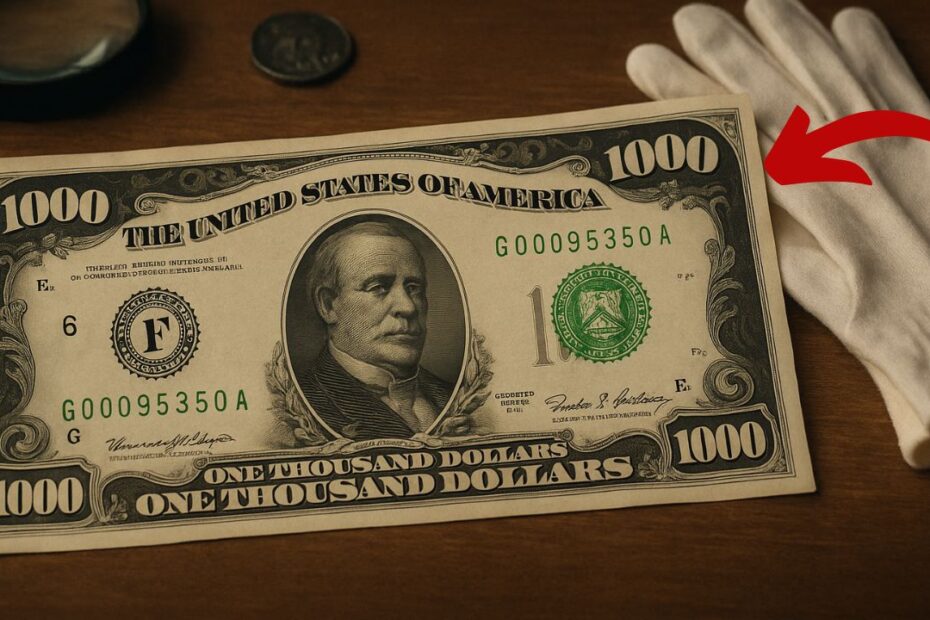The $1,000 bill—once a powerful symbol of economic heft—has nearly vanished from public circulation, yet it remains a treasured object for collectors and numismatists worldwide.
In this deep dive, we explore the fascinating history, design, intrinsic and collector worth, and the key reasons behind its removal from everyday use.
Expect detailed figures, design distinctions, and narrative that makes this article both engaging and search‑optimized for anyone curious about this rare denomination.
A Brief History of the $1,000 Bill
Early National and Large-Size Notes
- The $1,000 bill has roots reaching back to federal issuance beginning in 1861, as part of large‑denomination currency used for major financial transactions.
- In 1918, the Blue Seal version featured Alexander Hamilton on the obverse and a soaring American eagle on the reverse—a design aimed more at interbank use than general public circulation.
Series of 1928 and 1934: Small-Size Federal Reserve Notes
- Starting in 1928, the modern small‑size format (approximately 156 mm × 66 mm) replaced the larger notes.
- In the 1928 and 1934 Series of Federal Reserve Notes, the portrait shifted to President Grover Cleveland
- These small‑size $1,000 notes were last printed with Series 1934, although official production ended in 1945.
- On July 14, 1969, the Treasury and Federal Reserve announced the withdrawal of all high‑denomination bills ($500, $1,000, $5,000, $10,000) due to their low circulation and potential for misuse.
Why the $1,000 Bill Disappeared from Use
Several overlapping factors led to the phase‑out of the $1,000 bill:
- Lack of everyday use: By the mid‑20th century, few individuals needed physical notes of such high value, making them cumbersome and rarely handled.
- Shift towards electronic and banking transfers: Large sums became more safely and efficiently handled via wires and electronic systems, reducing the need for high‑value notes.
- Concerns over money laundering and illicit use: Large bills made cash‑based crime easier to conceal; discontinuation was viewed as a deterrent.
- Official policy: The 1969 announcement mandated all banks return such high‑denomination bills to the Treasury for removal from circulation—even though they remained legal tender.
Design & Physical Details
| Aspect | Details |
|---|---|
| Size | 156 mm × 66 mm (~6.14 × 2.61 inches) for small‑size notes |
| 1918 (Large-size) | Alexander Hamilton (obverse), American eagle (reverse) |
| 1928 & 1934 (Small-size) | Grover Cleveland (obverse) |
| Printing span | Issued until 1945; discontinued in 1969 |
| Legal status today | Still legal tender, but withdrawn from circulation |
Collectible Value: How Much Is the $1,000 Bill Worth?
Though out of circulation, these bills carry significant collector value, influenced by series, condition, seal color, and rarity:
- General range:
- Fair to Very Good: $1,500 or slightly above
- Fine to Very Fine: $1,800 – $3,500
- Extremely Fine to About Uncirculated: $4,000 – $5,500
- Uncirculated / Gem Quality: Tens of thousands USD, depending on rarity and serial numbers
- Auction highlights:
- A $5,000 bill (same era) fetched $144,000 at auction in 2024; another sold for $300,000 in 2023—highlighting how high‑denomination notes can command premium prices.
- Among $1,000 bills, sale listings show values ranging from $3,250 to over $16,500 for high‑grade specimens.
- Inflation context:
- The purchasing power of $1,000 in 1928 is roughly $18,800 in 2025 dollars
Snapshot Summary Table
| Feature | Details |
|---|---|
| Period of use | Issued: 1861–1945; withdrawn in 1969 |
| Portraits | 1918 – Hamilton; 1928/1934 – Grover Cleveland |
| Note dimensions | Small‑size: ~156 mm × 66 mm (~6.14 × 2.61 in) |
| Discontinuation reasons | Low public use, shifting payment systems, crime prevention |
| Current legal status | Legal tender, but not circulated |
| Collector value range | ~$1,500 (worn) to $5,000+ (near‑mint); rare pieces much higher |
| Inflation equivalent | $1,000 (1928) ≈ $18,800 today |
The $1,000 bill stands as a captivating chapter in the story of U.S. currency—bridging the eras of high-denomination cash, banking transformations, and modern collector culture.
Issued in different formats with Hamilton and Cleveland on its faces, it quietly faded from circulation amid changing financial practices and concerns over misuse.
Yet its legacy lives on in auction rooms, collector portfolios, and the annals of numismatic fascination.
Whether you’re delving into historical currency, chasing collector value, or simply curious about long-gone bills, the $1,000 note offers both rich narrative and tangible worth that continue to intrigue today.
Frequently Asked Questions
Is the $1,000 bill still legal?
Who appeared on the $1,000 bill and why?
The 1918 version featured Alexander Hamilton, a key figure in U.S. financial history.
The 1928 and 1934 small‑size versions depicted President Grover Cleveland. These portraits were chosen to reflect historical prominence, often on denominations not commonly seen in public use
What drives the collector value of a $1,000 bill?
Main factors include condition (grading from fair to gem mint), series and seal type, rarity, serial numbers, and provenance. Prices can range from approximately $1,500 for worn notes to tens of thousands for rare, uncirculated versions
